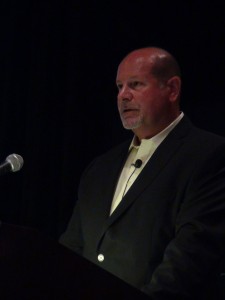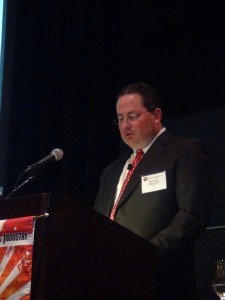Panel: US shale plays thrive as companies keep pace with technology, people challenges
By Joanne Liou, editorial coordinator

US shale plays continue to buzz, impacting the way the industry is approaching unconventional plays and transforming communities. “Without doubt, US shale plays have been an impact on this country in its entirety and sometimes more significant impact on certain locales,” Steve Carroll, drilling & completion manager, ConocoPhillips, said. “The activity has changed individual states’ economies and the standard of living.” Companies are stepping up strategies and technologies to meet opportunities in shale plays from the Bakken to the Eagle Ford.
In the Bakken alone, reserve estimates have grown exponentially since 1995, when the US Geological Survey estimated 151 million barrels. “The North Dakota Department of Mineral Resources figures that state’s portion of the basin has 11 billion recoverable barrels – up from the 2 billion the department estimated in 2008,” Mr Carroll said.
Mr Carroll was among two other panelists – Stacy Shivers, drilling engineering manager, Venado Oil & Gas; and Dave Bert, vice president – drilling, eastern division, Chesapeake Energy – who shared insights into their companies’ approach US shale plays and the associated challenges at the 2012 IADC Drilling Onshore Conference in Houston on 17 May. The session was moderated by Jay Minmier, president of NOMAC Drilling Co.
The Three Forks area of the Bakken is a focal point for ConocoPhillips, where the company plans to have nine to 10 rigs by year-end 2012, Mr Carroll stated. His company is also currently active in the Eagle Ford, Permian Basin and the Barnett and has plans for Niobrara in Colorado. Within the last year, Mr Carroll noted a dramatic increase in multi-well pads in the Bakken, which means less truck traffic and impact on surface while allowing use of centralized production facilities.

The “typical” Bakken rig has also undergone a transformation, with skidding capabilities and power generation using natural gas technology. “Newbuild rigs are dominating the additions to the rig count and have displaced older rigs without the safer, more efficient features like modern diesel motors, top drives, hydraulic catwalks, BOP systems and iron roughnecks,” he said.
With the increase in activity comes an increase in the demand for people and services. Growing the work force has been a particular challenge for the area, where rent in Williston, ND, for a one-bedroom apartment can run $2,400/month, Mr Carroll explained. Ranchers are allowed to have up to three campers per farmstead, and many are already at capacity and charge up to $1,000/camper/month.
Another challenge companies are confronting is rig mobilization along with truck traffic. Given that moving a rig can take six to seven days, in some cases, rig mobilization may represent about one-third of the total cycle time, Mr Bert explained. “Communication, planning and teamwork are fundamentals. It’s ABCs, 123s, but that’s the key – not rushing but working smart,” he said.
Chesapeake recently began an initiative to optimize rig moves by having proper resources, such as trucks and trains, and having permits ready in hand, making sure the location is properly sized. “We had a pad move about 25 miles that occurred in under four days,” Mr Bert said. “The previous best for that move was about seven days, and the average for the field was over eight. I’m excited about expanding that to our other rigs.”

Chesapeake has also invested resources into upgrading roads to sustain higher weight limits. “We’ve spent over $200 million in Pennsylvania, West Virginia and Ohio in the last two years on upgrading roads,” Mr Bert stated. “The roads up there are built for 15-ton load limit, and it takes few water trucks or a mud pump rig move, and it will bury those trucks up to the axel. We have to upgrade the roads to get permission to use them and even be able to bond them out.”
Sharing a small business approach to the burgeoning US shale market, Mr Shivers noted how quickly the market can change and the need “to be cognizant of the fact that there are a lot of things we don’t know.” For example, in 2008, the focus in the Eagle Ford was heavily on dry gas. “Two years later, the focus changed to shallow, low GOR and (becoming) extremely efficient at getting oil out of rock,” he said. “As we head into the future, we have to be ready no matter what.”
Venado, which was established in January 2011, takes a relationship-driven, hands-on approach to the business, Mr Shivers explained. The company is focused on its more than 100,000 gross operated acres in Eagle Ford with its partner, EOG Resources.
Venado takes a probabilistic approach to projects instead of deterministic, beginning with an evaluation of options from net pay to recovery factors, Mr Shivers explained. “Ultimately the question is: Are we going to make money on this?” Similar to how one might manage a 401K or IRA, the goal is to mitigate risk. Taking uncertainties into consideration, “we continue to navigate to do our business and stick with a philosophy that manages our capital,” he said. The company has strictly divided its investments into emerging, extension and proven projects to help reach its goal to obtain positions in all three project types in 24 months.
Across the board, technology remains key. History reflects the progression in conventionals from finding oil and gas in four-way closures in the early 1900s to finding stratigraphic traps today, Mr Shivers noted. “In the unconventional world we live in now, we’re just now scratching the surface. Technology is going to take us into the next realm, and there will be a tremendous amount of change.”




